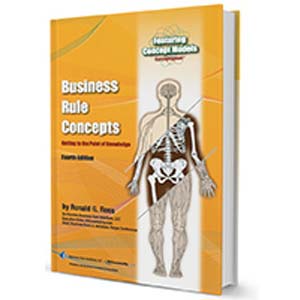Estimating the Time Required for Business Rules Harvesting — Part 2: Provide the Estimate
In Part 1 of this series, I provided 13 questions you must ask before estimating the time required for your business rules harvesting effort. With that information in hand, you can now carry on with your estimate. Given below is a guiding formula that I use to establish a baseline estimate of the project time required, based on my proposed number of minutes required per business rule. Use the answers to your 13 questions to then adjust the estimate as needed.
However, before jumping into heavy business rules harvesting activities, there is some preliminary work that you need to do. In fact, this pre-work is crucial to the success of your effort.
Allow 1-2 weeks to:
Now, let's proceed with the baseline formula:
| Baseline average time per business rule = 45 minutes |
These 45 minutes include:
- specification of the business rule into business rule statements,
- analysis of the business rule set for conflict, duplication, or gaps,
- setting up of some basic traceability elements, and
- two external reviews.
Next, adjust your estimate by the following:
|
Questions |
Your answer can be: |
Adjustment |
|
|
The baseline assumption is Ongoing business rules management by the business. If your answer is either System Implementation or Both, you can actually reduce the estimate. You save time by not having to organize your business rules for ongoing management. |
|
|
The baseline assumption is Decision Rules. If your answer is Behavioral Rules, you might need to add more time. This is because Behavioral Rules are often not documented. They are in people's heads, and different people might have different ideas for a given rule. The good news is that the number of Behavioral Rules is likely to be a lot less than the number of Decision Rules for a given scope. The total amount of time for harvesting a set of Behavioral Rules is likely to be less than the total amount of time needed to harvest a set of Decision Rules. |
|
|
The baseline assumption is that subject area experts are available and that subject area experts are familiar with the scoped business area. Naturally, more time would be required if a subject area expert is not available and is not familiar with the business. |
|
|
The baseline assumption is that the source materials can be understood directly (i.e., in 1 or 2 readings) without a lot of explanation from subject area experts. More time would be required if the source materials need a lot of explanation from subject area experts. |
|
|
The baseline assumption is 800-1000 decision rules or 400-500 behavioral rules. Having more business rules would mean more relationships between the rules and therefore more analysis. More time would be needed. A smaller number of rules would mean less time per rule. |
|
|
Terminology is the backbone of business rules. The baseline assumption is that the scoped area uses consistent terminology and that the stakeholders of the area know the importance of consistent terminology usage. More time would be required if the scoped area needs to be educated on the importance of vocabulary. |
|
|
An already-approved terminology model can save a lot of time on business rules specification. The assumption is that there is no terminology model. Less time would be required if a terminology model exists that covers more than 70% of the vocabulary used in the business rules. |
|
|
The assumption is that the business (rule) analysts already have experience in harvesting business rules for 2 or more projects. More time would be required if the business (rule) analysts do not have the necessary training or experience. |
|
|
The baseline assumption includes 2 external review cycles. More external reviews would mean more time required. Fewer external reviews might not be wise. |
|
|
The baseline assumption is 3-5 traceability elements. More traceability elements would mean more time to collect and maintain information. |
|
|
The baseline assumption is medium complexity of the entire rule set. It is expected that some rules might be very simple and some are highly complex. If most business rules are simple, then less time. If most business rules are highly complex, then more time. |
|
|
The baseline assumption is harvesting one set of business rules. If you need to harvest the 'as-is' business rules and then re-engineer them as 'to-be' business rules, you will need more time since there are going to be more and different business rules resulting from the re-engineering effort. |
|
The assumption is that you have some basic tool to help you with capturing, analyzing, organizing, and reporting on business rules. Expect more time will be required if you have inadequate tool support. Some automated tools allow you to go from capture, to analysis, to implementation very quickly. The emphasis is still on the correct specification of the business rule logic. Veronica O'Grady from New Zealand's Inland Revenue Department has documented how they were able to implement 3500 pages of tax law in 12 months — an incredible success story for using the business rules approach.[3] |
Just Remember…
Plainly speaking, here are some of the main things you need to remember:
- The baseline time estimate provided depends heavily on answers to the 13 key questions provided in Part 1 of the series.
- An automated tool can help with analysis, management, testing and implementation of the business rules and decisions; however, the harvesting and specification of the correct business logic is still in the hands of a good business (rule) analyst.
- It is not about how many business rules and decisions you can capture and implement in how short a time. It is how many CORRECT business rules and decisions you can implement that bring benefit to your organization.
[1] Business Rule Concepts: Getting to the Point of Knowledge (Fourth Edition), by Ronald G. Ross (2013). ISBN 0-941049-14-0, URL: http://www.brsolutions.com/publications.php#books ![]()
[2] Building Business Solutions: Business Analysis with Business Rules, by Ronald G. Ross with Gladys S.W. Lam, An IIBA® Sponsored Handbook, Business Rule Solutions, LLC, October 2011, 304 pp. URL: http://www.brsolutions.com/bbs ![]()
[3] "Establishing an Enterprise Rule Management Capability," by Veronica O'Grady, presented at Business Rules Forum (2012), Hollywood, FL, USA. Veronica will be sharing her success in a future article on BRCommunity. Stay tuned, or contact me for more details. ![]()
# # #
About our Contributor:
Online Interactive Training Series
In response to a great many requests, Business Rule Solutions now offers at-a-distance learning options. No travel, no backlogs, no hassles. Same great instructors, but with schedules, content and pricing designed to meet the special needs of busy professionals.











How to Define Business Terms in Plain English: A Primer
How to Use DecisionSpeak™ and Question Charts (Q-Charts™)
Decision Tables - A Primer: How to Use TableSpeak™
Tabulation of Lists in RuleSpeak®: A Primer - Using "The Following" Clause
Business Agility Manifesto
Business Rules Manifesto
Business Motivation Model
Decision Vocabulary
[Download]
[Download]
Semantics of Business Vocabulary and Business Rules